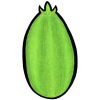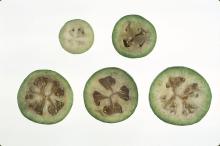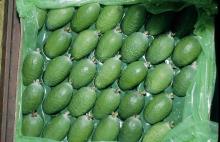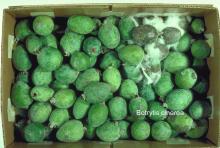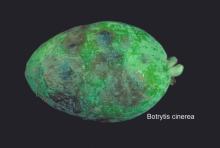Product Description
Maturity and Quality
- Change in skin color from dark-green to light-green
- Retention force (ease of fruit separation from the tree). Touch-picking is recommended
- Feijoas must be picked close to abscission time but before dropping onto the ground to assure good appearance and flavor quality
- Color
- Shape
- Size
- Freedom from defects, such as physical injury, scars, skin browning, and chilling injury
- Freedom from decay
- There are major differences among cultivars in soluble solids (10-16%), titratable acidity (0.3-1.4%), and pH (3.2-4.4)
Methyl benzoate, ethyl benzoate, and ethyl butanoate are important in the aroma of feijoa fruit.
Postharvest Handling and Storage
5°C ± 1°C (41°F ± 2°F)
Storage potential is 4-5 weeks, depending on cultivar and ripeness stage.
10-15 ml CO2/kg·hr (climacteric minimum) and 20-25 ml CO2/kg·hr (climacteric maximum) at 20°C (68°F).
To calculate heat production multiply ml CO2/kg·hr by 440 to get Btu/ton/ day or by 122 to get kcal/metric ton/day.
Postharvest exposure to ethylene [10-100 ppm for 24 hours at 20°C (68°F)] enhances loss of green color and softening, but does not influence flavor.
90 to 95%
Packaging in perforated plastic bags or box liner is effective in reducing water loss under lower relative humidities.
0.1-0.4 µl/kg·hr (climacteric minimum) to 40-50 µl/kg·hr (climacteric maximum) at 20°C (68°F).
Disorders
Chilling injury. Exposure to 0°C (32°F) for 3 weeks or longer results in chilling injury as indicated by sunken spots at the stem end and internal browning of the vascular elements.
Botrytis cinerea. This fungus can result in significant postharvest losses. Control strategies include avoiding grounded and physically-damaged fruit and maintaining optimum fruit temperature throughout the postharvest handling system.



